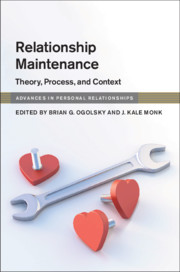Book contents
- Relationship Maintenance
- Advances in Personal Relationships
- Relationship Maintenance
- Copyright page
- Contents
- Tables
- Figures
- Contributors
- Part I Introduction
- Part II Theories of Relationship Maintenance
- Part III Processes of Relationship Maintenance
- Part IV The Social Context of Relationship Maintenance
- 14 Gender and Race Perspectives on Relationship Maintenance
- 15 Relationship Maintenance across Cultural Groups
- 16 Relationship Maintenance in the Age of Technology
- 17 Relationship Maintenance across the Life Course
- 18 Relationship Maintenance in Couple Therapy and Relationship Education
- Part V Conclusion
- Index
- References
17 - Relationship Maintenance across the Life Course
from Part IV - The Social Context of Relationship Maintenance
Published online by Cambridge University Press: 02 December 2019
- Relationship Maintenance
- Advances in Personal Relationships
- Relationship Maintenance
- Copyright page
- Contents
- Tables
- Figures
- Contributors
- Part I Introduction
- Part II Theories of Relationship Maintenance
- Part III Processes of Relationship Maintenance
- Part IV The Social Context of Relationship Maintenance
- 14 Gender and Race Perspectives on Relationship Maintenance
- 15 Relationship Maintenance across Cultural Groups
- 16 Relationship Maintenance in the Age of Technology
- 17 Relationship Maintenance across the Life Course
- 18 Relationship Maintenance in Couple Therapy and Relationship Education
- Part V Conclusion
- Index
- References
Summary
By its very definition, relationship maintenance implies development within intimate relationships. Whether couples are engaging in activities that keep relationships in good repair or even just in existence, the underlying assumption is clear – the natural state of relationships, if left unattended to, is to deteriorate. Once a relationship starts, therefore, romantic partners must engage in a broad array of maintenance strategies to preserve their relationships, though the form and function of these strategies are likely to change as the partners develop across the life course. Despite the clearly developmental concept of relationship maintenance, scholars have argued that the approach to its study has remained relatively static and disproportionately focused on younger, less established couples. The goal of our chapter is to utilize life course theory to consider the extent to which relationship maintenance strategies vary according to the developmental stage of both the relationship and the individuals within it, as well as to explore whether the antecedents and consequences of relationship maintenance may change across the life course. Our review underscores the need for more developmentally oriented research, which could not only advance theory on what relationship maintenance entails but also elucidate why, when, and how partners engage in it.
Keywords
- Type
- Chapter
- Information
- Relationship MaintenanceTheory, Process, and Context, pp. 323 - 338Publisher: Cambridge University PressPrint publication year: 2019

